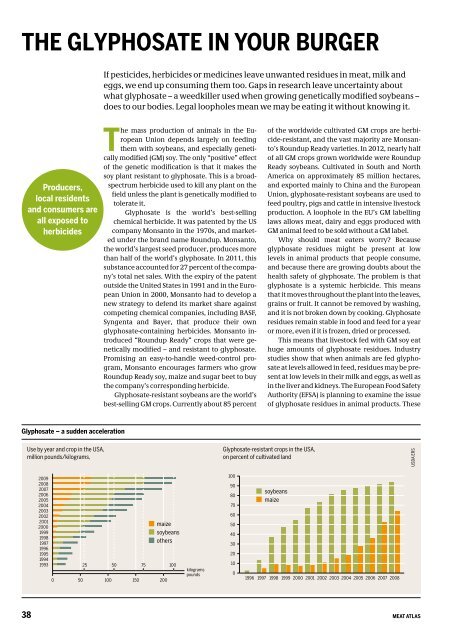1jjtwKx
1jjtwKx
1jjtwKx
Create successful ePaper yourself
Turn your PDF publications into a flip-book with our unique Google optimized e-Paper software.
THE GLYPHOSATE IN YOUR BURGERIf pesticides, herbicides or medicines leave unwanted residues in meat, milk andeggs, we end up consuming them too. Gaps in research leave uncertainty aboutwhat glyphosate – a weedkiller used when growing genetically modified soybeans –does to our bodies. Legal loopholes mean we may be eating it without knowing it.Producers,local residentsand consumers areall exposed toherbicidesThe mass production of animals in the EuropeanUnion depends largely on feedingthem with soybeans, and especially geneticallymodified (GM) soy. The only “positive” effectof the genetic modification is that it makes thesoy plant resistant to glyphosate. This is a broadspectrumherbicide used to kill any plant on thefield unless the plant is genetically modified totolerate it.Glyphosate is the world’s best-sellingchemical herbicide. It was patented by the UScompany Monsanto in the 1970s, and marketedunder the brand name Roundup. Monsanto,the world’s largest seed producer, produces morethan half of the world’s glyphosate. In 2011, thissubstance accounted for 27 percent of the company’stotal net sales. With the expiry of the patentoutside the United States in 1991 and in the EuropeanUnion in 2000, Monsanto had to develop anew strategy to defend its market share againstcompeting chemical companies, including BASF,Syngenta and Bayer, that produce their ownglyphosate-containing herbicides. Monsanto introduced“Roundup Ready” crops that were geneticallymodified – and resistant to glyphosate.Promising an easy-to-handle weed-control program,Monsanto encourages farmers who growRoundup Ready soy, maize and sugar beet to buythe company’s corresponding herbicide.Glyphosate-resistant soybeans are the world’sbest-selling GM crops. Currently about 85 percentof the worldwide cultivated GM crops are herbicide-resistant,and the vast majority are Monsanto’sRoundup Ready varieties. In 2012, nearly halfof all GM crops grown worldwide were RoundupReady soybeans. Cultivated in South and NorthAmerica on approximately 85 million hectares,and exported mainly to China and the EuropeanUnion, glyphosate-resistant soybeans are used tofeed poultry, pigs and cattle in intensive livestockproduction. A loophole in the EU’s GM labellinglaws allows meat, dairy and eggs produced withGM animal feed to be sold without a GM label.Why should meat eaters worry? Becauseglyphosate residues might be present at lowlevels in animal products that people consume,and because there are growing doubts about thehealth safety of glyphosate. The problem is thatglyphosate is a systemic herbicide. This meansthat it moves throughout the plant into the leaves,grains or fruit. It cannot be removed by washing,and it is not broken down by cooking. Glyphosateresidues remain stable in food and feed for a yearor more, even if it is frozen, dried or processed.This means that livestock fed with GM soy eathuge amounts of glyphosate residues. Industrystudies show that when animals are fed glyphosateat levels allowed in feed, residues may be presentat low levels in their milk and eggs, as well asin the liver and kidneys. The European Food SafetyAuthority (EFSA) is planning to examine the issueof glyphosate residues in animal products. TheseGlyphosate – a sudden accelerationUse by year and crop in the USA,million pounds/kilograms,Glyphosate-resistant crops in the USA,on percent of cultivated landUSDA ERS200920082007200620052004200320022001200019991998199719961995199419930 50 100 150 200maizesoybeansothers25 50 75 100kilogramspounds1009080706050403020100soybeansmaize1996 1997 1998 1999 2000 2001 2002 2003 2004 2005 2006 2007 200838MEAT ATLAS


